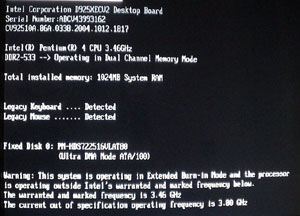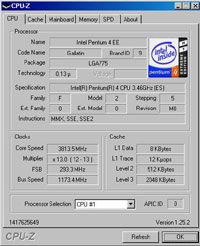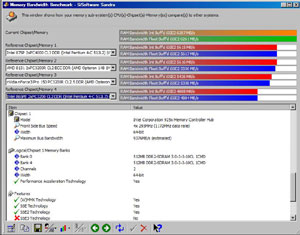|
|
Advertisement:
|
|
Intel 925XE Chipset and 3.46GHz Extreme Edition CPU |
|
Join the community - in the OCAU Forums!
|
Overclocking, Summary, Conclusions and Recommendations
OVERCLOCKING:
After all tests were done at the stock speed of 3.46 GHz we finally checked out Intel’s “burn-in” function. It allows via BIOS or Intel’s propriety “Desktop Control Centre” to raise the system-bus frequency 10% above stock frequency. Our 3.46 GHz EE engineering sample came with a selectable 12x and 13x multiplier. We kept the multiplier at 13x and increased the FSB frequency in several steps until we finally reached the maximum allowed frequency of 293 MHz. Intel does not take any chances with their “burn-in” function. The first thing the user sees after changing the system-bus speed and rebooting is a boot-screen warning that “the processor is now operating outside of Intel’s warranted and marked frequency”.

Well, no risk, no fun! We found that the system was completely stable running at the maximum allowed frequency of 13x 293 MHz= 3813 MHz. Considering that this was done without increasing the CPU voltage (which is anyway not possible with this board) and we only used the Intel standard heatsink, we assume that the D925XECV2 has much more overclocking headroom than the allowed 10%. Unfortunately there is no way to find out with the current BIOS 10% limitation, and that will of course keep hardware enthusiasts away from the D925XECV2.

After increasing the memory voltage to 1.9 volt our Crucial Ballistix DDR2 667 had no problem to run at 2x293 MHz with timings of 3-3-3-10. We also tried to run CPU and memory asynchronous at 4:5, or 533:667. The BIOS is providing a setting for a memory frequency of 667 MHz. But whatever we tried it was impossible to boot at this speed.

The Sandra bandwidth benchmark shows how well the 925XE memory bandwidth is scaling upwards in 1:1 with increasing system bus frequency: At 266 MHz we got around 5700 MB/sec, and at 293 MHz we are already at 6200 MB/sec. It will be very interesting to see how this chipset is overclocking on high-end motherboards from ABIT and the like.
SUMMARY, CONCLUSIONS, AND RECOMMENDATIONS:
The 925XE chipset is currently Intel’s best performing and most feature-rich chipset for desktops and workstations. The change from 800 MHz to 1066 MHz is increasing the bandwidth between CPU and memory controller from 6.4 to 8.5 GB/sec and by this equalizing the bandwidth between system memory and CPU. The actual bandwidth gain we achieved was a very satisfying 900 MB/sec or 19%.
On the features side, the 925X/925XE + ICH6-R combination offers many advantages in comparison with its predecessor, the venerable 875P + ICH5-R Southbridge. Namely, support for DDR2, EM64T, 8-channel sound in 192 kHz/32-bit quality, Matrix RAID, 4 native SATA 150 channels, native command queuing, as well as PCI-Express. Each of these features has (or will offer in the near future) tangible benefits for desktop computing. The combination of 4 SATA channels and Matrix RAID makes motherboards with the ICH6-R a first choice for RAID users. The new features come unfortunately for a very high price. Upgrading from an 8x5 system means to invest heavily - a new (LGA 775) CPU, new (DDR2) memory and a new (PCI-Express) video card. Few of the components used on an 8x5 based system can be used with a 925XE based motherboard.
The only thing we missed with the 925XE is the lack of “official” support for DDR 667. Also, adding a dual PCI-Express graphic interface would make the 925XE the perfect platform. In order to exploit the increased bandwidth headroom between CPU and 925XE MCH a matching processor with a 1066 MHz system bus is necessary. Currently and probably also for the future, such a processor is only available from the Extreme Edition range. Processors of this series are very expensive and out of the reach for many users.
Nevertheless we recommend that any buyer should insist to get a 925XE instead of a 925X. Even when running a 925XE based board with a 500 series Pentium 4 (800 MHz FSB), the additional “headroom” the 925XE chipset offers will certainly come in handy for overclocking. The same goes for the 925XE’s validation for DDR2 553 with CL 3 instead of the 925X slower CL 4 memory. As far as we know, Intel is charging the same price for the 925XE chipset as 925X and there is no reason why 925XE boards should be more expensive than 925X boards.
D925XECV2 Motherboard:
Intel’s 925XE based D925XECV2 motherboard was a pleasant surprise in our test. The quality and reliability of Intel motherboards is well known, even if they are not popular choices for enthusiasts. To have the processor, chipset and mainboard designed and validated by the same manufacturer is certainly an advantage, because nobody would expect Intel to design motherboards that let their own chipsets and processors down. The D925XECV2 was 100% stable in all our tests.
This board offers more tweaking and overclocking options than any other Intel-branded motherboard before. We managed to bring the tested 3.46 GHz EE processor up to the maximum allowed 3.81 GHz even without additional voltage and without compromising stability. Another plus is the rich software bundle and the boards advanced thermal monitoring and control system. However, given the 10% overclocking limitation and lack of CPU voltage adjustment, enthusiasts will still look somewhere else.
3.46 GHz EE CPU:
The new 3.46 GHz Extreme Edition with a 1066 MHz system bus is a mixed bag. It is currently the best performing desktop processor Intel has to offer. As member of Intel’s “Extreme Edition” series it offers, for many desktop tasks, tangible benefits from its huge 2 MB L3 cache. The average performance gain by “widening” the system bus from 800 to 1066 MHz is between 3% in applications and 6% in games. Such a small gain is not enough to convince a 3.40 GHz EE (800 MHz FSB) owner to invest into the new 1066 MHz processor and a new 925XE motherboard. Our tests showed that the new 3.46 GHz EE is up to 15% faster than a similar clocked 3.40 GHz Pentium 4 550. Yet we hesitate to recommend this processor. The 3.46 GHz EE is retailing for around 1000 US$. The Prescott based Pentium 4 550 costs around 70% less than the 3.46 GHz EE. A performance gain of up to 15% is hardly justifying such a huge price difference, and that does not even include the cost for the other hardware required to build a 925XE system from scratch.
That leaves the target audience for the 3.46 GHz EE as those who are currently considering a whole new Intel system and don’t want to settle for anything less than Intel’s fastest performing processor. These shoppers are naturally looking at the Extreme Edition and for them a 925XE chipset based motherboard with a 3.46 GHz EE is the way to go. But these consumers probably also know that AMD’s FX55 performs even better when it comes to the all important gaming. Such a high-end enthusiast will certainly also notice that Intel’s current Gallatin based Extreme Edition does not offer support for future 64-bit computing.
Final Words:
Increasing the system bus frequency from 800 MHz to 1066 MHz is a step in the right direction. The performance gain is small, but visible. Because of this and the many new features the 900 chipset family brings to desktop computing, Intel’s new 925XE chipset and their 925XE based D925XECV2 motherboard get our full endorsement. But to make the 925XE more appealing for owners of 875P systems and the high-end competition from AMD we feel that a processor frequency of 3.46 GHz is not enough, even when the processor is endowed with a generous L3 cache of 2 MB. For the time being Intel obviously will keep 1066 MHz reserved for the Extreme Edition series. If this is true we will probably see in the near future a 3.73 GHz Extreme Edition clocked at 14 x 266 MHz. Intel roadmaps show that future Extreme Editions will be based on the Prescott core with even better performing 2 MB of L2 cache instead of the Gallatin’s 2 MB of L3 cache. A Prescott based 3.73 GHz Extreme Edition running at 1066 MHz with 2 MB L2 cache would be a very appealing product. It’s also clear that current mainstream DDR2 533 running at 3-3-3-8 is holding the 925XE chipset back because of its relative high latency. To sum it up: The 925XE looks good, but its full potential has certainly not yet been unleashed. We are looking forward to re-visit this chipset when DDR2 memory with lower latency and retail boards with a full range of overclocking features are available. Stay tuned for our review of ABIT’s Fata!lity AA8 and OCZ DDR2 533 memory running at 3-2-2-3.
Technical documentation for the discussed hardware items:
Intel 925X/925 Chipset (Memory Controller Hub: here.
Intel I/O Controller Hub (ICH6 Family): here.
Intel Pentium 4 Processor Extreme Edition LGA Package: here.
Intel D295XE Motherboard Technical Specifications: here.
Be sure to check out OCAU's Intel Hardware Forum for the latest info.
|
|
Advertisement:
All original content copyright James Rolfe.
All rights reserved. No reproduction allowed without written permission.
Interested in advertising on OCAU? Contact us for info.
|

|


